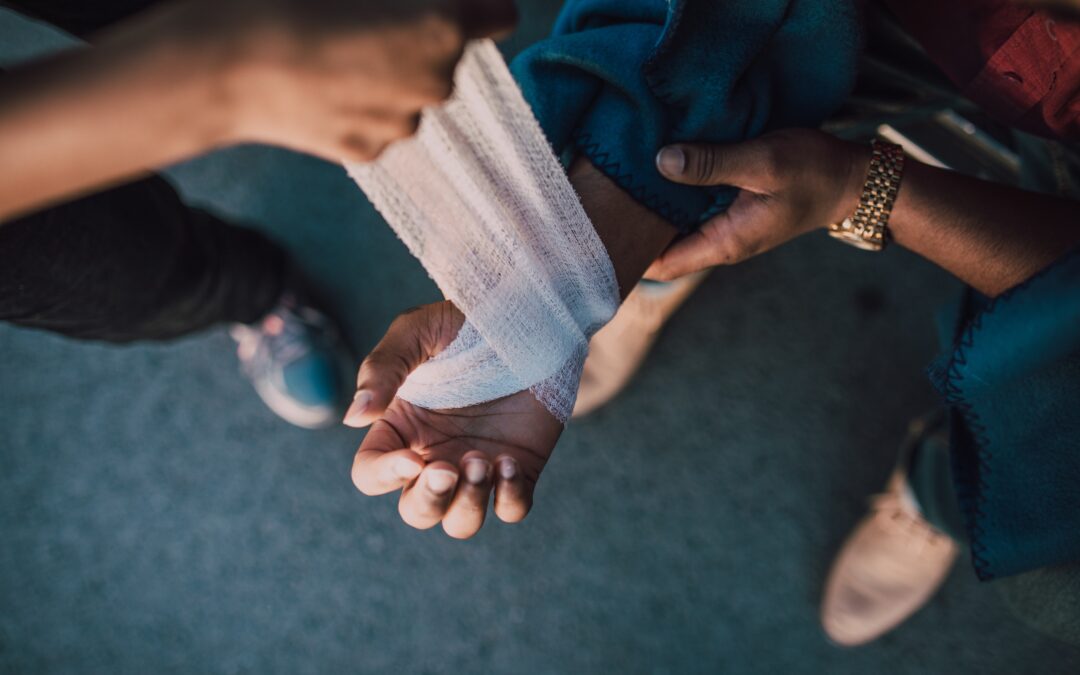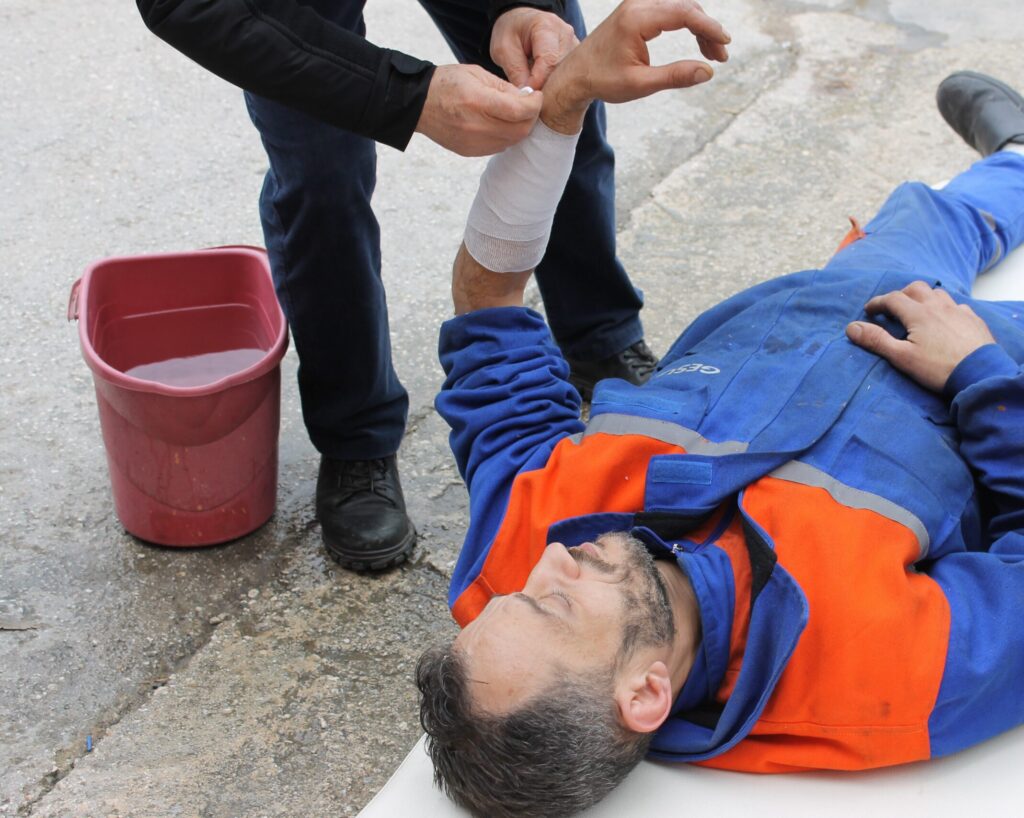First Aid, it’s a valuable life skill that many people across the world train in and use during their everyday lives. First Aid training can range from being one day long in a classroom with work colleagues to being a week long outdoor expedition course. In this short interview with two of our members: Graham and Adrian, we take a look at how and why casualty simulation can make everyone a better first aider.
Graham and Adrian, thanks for giving up your time for this interview. Before we start I wanted to explain to everyone that you are current volunteers for Casualties Union but before joining you were both first aiders in various capacities.
How do you think most people would describe a standard day of first aid training without casualty simulation?
Graham: Many people I think would describe the overall learning process as boring. There is often a lot of learning from presentations or demonstrations but actually not a lot of ‘doing’!
Adrian: It’s not very challenging either, at least not until you get to the more advanced levels of training within first aid.
Are there any particular aspects of first aid that you felt were always unrealistic?
Graham: Practising key first aid skills with course colleagues. It often ends up in laughter and whilst it is funny at that moment, you lose awareness of how serious the situation could become and how you would deal with it in real life.
Adrian: Especially when there is no makeup and no real effort in acting too.
Can you recall the first time that you came across casualty simulation or moulage makeup?
Graham: I first came across moulage during battlefield simulation in the army. It looked and felt very real at the time. There was a lot of pressure to react to a ‘real’ situation which heightened our senses, especially as we were infrequently told that it was a simulation with the makeup being extremely realistic.
Adrian: I had a very different experience. My introduction to the world of moulage was through plastic fake wounds but it was better than nothing as it gave me something to focus on. However, it also, inspired me to investigate what else was available in the world of injury simulation.
Using only a few words, can you describe first aid training with the use of live casualties?
Adrian: Realistic, more challenging and thought provoking!
Graham: I’d agree! Adding perhaps the word ‘scary’ when on battlefield simulations.
In what ways has casualty or injury simulation made training more realistic for you?
Adrian: Acting as a casualty I noticed more how treatments were carried out on a personal level with better communication, not just between the first aider and the casualty but also interactions with other first aiders. I’ve definitely been able to pick up better practices and self-reflect on how I deal with incidents.
I want to take a look at a specific first aid training scenario: dealing with an unconscious casualty that is breathing. How does a scenario like this differ when you are training with a colleague or friend compared with an individual trained in casualty simulation?
Adrian: I’ve often noticed that colleagues or friends rarely act floppy enough for the recovery position, they are unrealistic and end up unintentionally helping the first aider. Those trained in casualty simulation are a lot more realistic, they don’t smile or giggle, and they give the right reactions to changes or not react at all as the case may be.
Graham: A Casualties Union volunteer is trained to become a dead weight. For us, and others who are trained in casualty simulation, acting as an unconscious person isn’t just about closing your eyes and lying still. It’s an art that requires a lot of concentration and understanding of how our bodies function.
What is it like ‘being on the other side’? What observations do you make?
Adrian: It’s easier to observe and see other techniques or communication styles as a patient (both good and bad). I find I can use my own experiences and emotions to react to how I am being treated.
Sarah: I would also add that when you are sitting outside in the cold or in the rain, time feels like it has stopped. It’s easy to think you’ve been waiting over 30 minutes for emergency teams to arrive when, in reality only 10 minutes have passed.
What do you think are the main benefits of the use of casualty simulation in training?
Adrian: Having the confidence to treat someone without freezing or being overwhelmed by the sight of injuries. I had recently had a fellow first aider come and thank me following an injury simulation that I had done. They had come across a car accident where the driver had open leg fractures. Instead of not being able to do anything they were able to help despite the traumatic sight and nature of the injury; they put that down to seeing moulage and casualty simulation beforehand.
Graham: I would add that one of the main benefits to working with a casualty actor during training is that you can make the mistakes with them and receive vital feedback afterwards. You can continue to practise key skills and increase your confidence in communicating with others so that you are ready for the real life scenarios.
Putting your first aider hat on, and thinking about a previous occasion where you have done training scenarios involving ‘live casualties’ how did it challenge you?
Adrian: I remember dealing with a simulated acid attack scenario where the nurse went in front and got grabbed by the ‘contaminated’ patient. As the danger hadn’t been assessed initially they had to be ruled out of the scenario and I then had to step in as the person in charge. We talk about danger, or scene safety, during training but simulated scenarios really make you more aware of your surroundings in a safer way.
How has your casualty simulation experience made you a better first aider?
Adrian: I have more confidence treating others, a better understanding of the symptoms and what they could be as well as how they are presented.
Graham: I feel that it has made me change my attitude towards a casualty, I am certainly more empathetic to their situation.
Adrian: Yes, you certainly gain that empathy and willingness to spend time with each person.
Thinking about those who are new to the world of first aid or casualty simulation there are no doubt many hints and tips that would be useful to them.
What words of advice would you give to someone who is new to first aid?
Adrian: Don’t panic, it’s fine to take a few seconds and some deep breaths to think. Taking a pulse if you carry on as though you’re still taking it for a few seconds more can buy you thinking time and give the patient some confidence in you. Observe others’ treatment to see what they do well and don’t.
Graham: Yes, “don’t panic” are two key words everyone should remember. Take control of the situation as the first aider and give yourself time to think about your casualty and their injuries.
What hint(s) would you give to someone who is new to casualty simulation?
Graham: If you have free time before an exercise or duty, use it to observe others and ask questions, you’ll learn many tips from those observations.
Adrian: I’d add that you should always research what is real and what is not. The web has great resources for real wounds and unfortunately some not so good examples of fake, anatomically incorrect wounds. The NHS website is also a great resource for some symptoms that may be presented.
Sarah: I would also add that new starters shouldn’t focus on just makeup either. It is very easy to get caught up and spend a lot of money on various special effects products for injury simulation, yet makeup is only one key part of a scenario. Time should be spent understanding how to correctly act an injury out even if that’s by asking a first aider or someone in a similar role.
Thank you both for taking part and providing very interesting insights into the world of casualty simulation from a first aider’s perspective.
Find out more
The charity Casualties Union has been helping training providers make their first aid simulations more realistic for the past eighty years! You can learn about what Casualties Union do, request their assistance for your first aid training or make an enquiry about volunteering by visiting our Contact page or by calling 08700 780 590. Don’t forget to also explore our social media accounts on Facebook or LinkedIn for all the latest news and stories about our charity.
Photos provided with thanks from: RODNAE Productions and Elif



Recent Comments